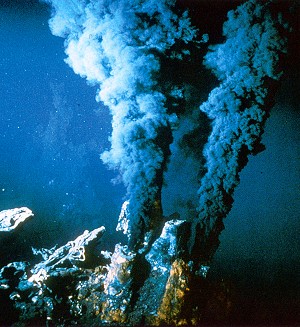
Deep Sea Vents

Deep Sea Vents
Most of us are familiar with "Old Faithful" in Yellowstone National Park. This famous geyser erupts several times a day. It spouts a column of water heated by volcanic rock deep within the Earth's crust. In another area where people are as familiar with there exists another "type" of geysers. Deep sea vents are "geysers" that occur on the ocean floor and spew hot, mineral-rich water, that help support a diverse community of organisms. These vents, also known as hydrothermal vents, are thought to have been around for 3.5-4.0 billion years, but were just discovered in the late 1970's. Hydrothermal vents can be found in the Pacific and Atlantic oceans. Most are found at an average depth of 2,500 meters, which is much deeper than where cold seeps would be found.
In some areas along the Mid-Ocean Ridge, the gigantic plates that form the Earth's crust are moving apart, creating cracks and crevices in the ocean floor. Seawater seeps into these openings and is heated by the molten rock, or magma, that lies beneath the Earth's crust. As the water is heated, it rises and seeks a path back out into the ocean through an opening in the seafloor. As the vent water bursts out into the ocean, its temperature may be as high as 400 oC. Yet the water does not boil because of the incredible pressure from the mass of the ocean.
|
|
On top of the hydrothermal vents are
chimneys or "hot
smokers." These smokestacks are
formed from dissolved metals that precipitate out when the
super-hot vent water meets the ocean water, which is only a
few degrees about freezing. There are two different types of
smokers. "Black" smokers are the hotter of the two. They
release mostly iron and sulfide, which gives the smoker its
black appearance. "White" smokers release water at a much
cooler temperature and contains compounds of barium,
calcium, and silicon. These elements help give the smoker a
white appearance.

Scientists are enthralled by the unusual
life that inhabits the vent sites. Since temperatures are so
high in the vents, it is amazing that it can support life
forms. One type of organism that can thrive alone or in
symbiotic relationships with other organisms is the extreme
thermophilic microbes. These microbes belong the the Domain
Archaea.
The picture to the left of the text shows microbe particles
being spewed from the smokers. Many other organisms survival
in the deep sea vents is dependent upon microbes. Without
the microbes, they would not be able to produce nourishment
for themselves. Microbes that are
found in the giant tubeworms and mussels are
sulfur-oxidizing bacteria that gain energy by the metabolism
of inorganic compounds.

Similiar to the cold seeps, there are
organisms that are ambiguous to the hydrothermal vent as
well. The giant tubeworms are found in the deep sea vents.
The only difference between their cold seep cousins is that
they will grow at a much quicker rate, yet live a much
shorter life. One organism that has only been found in
hydrothermal vents are the Pompeii worm (Alvinella
pompejana). The Pompeii worm is the most heat-tolerant
animal on Earth. The worm is covered in bacteria that can
also "take the heat." These bacteria are of particular
interest to industry because they may harbor enzymes that
are useful in high-temperature applications.

Deep sea vents have many various important qualities. Scientists are interested in how each vent community is different. The deep sea vents also hold much interest in terms of industrial significance. Petroleum in vents appears to form after thousands of years, rather than millions of years. Learning more about the extremophiles that can exist in the deep sea vents may lend insight into high-temperature applications, such as processing food and drugs and making paper. If you would like to learn more about deep sea vents (hydrothermal vents), visit our links page for some web sites.
|
|
|
|
|
|